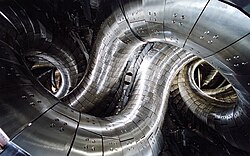Large Helical Device
| Large Helical Device | |
|---|---|
 | |
| Device type | Heliotron |
| Location | Toki, Japan |
| Technical specifications | |
| Major radius | 3.5 m (11 ft) |
| Minor radius | 0.6 m (2 ft 0 in) |
| Magnetic field | 3.0 T (30,000 G) |
| History | |
| Year(s) of operation | 1998–present |
The Large Helical Device (大型ヘリカル装置, Ōgata Herikaru Sōchi) (LHD) is a fusion research device in Toki, Gifu, Japan, belonging to the National Institute for Fusion Science. It is the second largest superconducting stellarator in the world, after the Wendelstein 7-X. The LHD employs a heliotron magnetic field originally developed in Japan.
The objective of the project is to conduct fusion plasma confinement research in a steady state in order to elucidate possible solutions to physics and engineering problems in helical plasma reactors. The LHD uses neutral beam injection, (ICRF), and electron cyclotron resonance heating (ECRH) to heat the plasma, much like conventional tokamaks.
History[]
- Design finalized 1987
- Start of construction 1990
- Plasma operations from 1998
- In 2006 a new helium cooler was added. Using the new cooler, by 2018 a total of 10 long term operations have been achieved, reaching a maximum power level of 11.833 kA.[3]
- To aid public acceptance, an exhaust system was designed to catch and filter the radioactive tritium the fusion process produces.[4]
This section needs expansion. You can help by . (March 2018) |
See also[]
- Fusion reactor
- National Institutes of Natural Sciences, Japan
References[]
- ^ Fujiwara, M.; Yamada, H.; Ejiri, A.; Emoto, M.; Funaba, H.; Goto, M.; Ida, K.; Idei, H.; Inagaki, S.; Kado, S.; Kaneko, O.; Kawahata, K.; Kobuchi, T.; Komori, A.; Kubo, S.; Kumazawa, R.; Masuzaki, S.; Minami, T.; Miyazawa, J.; Morisaki, T.; Morita, S.; Murakami, S.; Muto, S.; Mutoh, T.; Nagayama, Y.; Nakamura, Y.; Nakanishi, H.; Narihara, K.; Nishimura, K.; et al. (1999). "Plasma confinement studies in LHD". Nuclear Fusion. 39 (11Y): 1659–1666. doi:10.1088/0029-5515/39/11Y/305.
Heating by NBI of 3 MW produced plasmas with a fusion triple product of 8 × 1018m−3 keV s at a magnetic field strength of 1.5 T. An electron temperature of 1.5 keV and an ion temperature of 1.1 keV were achieved simultaneously at a line averaged electron density of 1.5 × 1019 m−3
- ^ Achievement of One Hour Discharge with ECH on LHD 2005
- ^ Hamaguchi, Imagawa, Obana, Yanagi and Mito (2018). "Operations of the Helium Subcooling System for the LHD HelicalCoils during Ten Plasma Experimental Campaigns". Plasma and Fusion Research. 13: 4. doi:10.1585/pfr.13.3405057.CS1 maint: multiple names: authors list (link)
- ^ "Design and commissioning of the exhaust detritiation system for the Large Helical Device". ResearchGate. Retrieved 2019-03-04.
External links[]
- Large Helical Device Website good diagrams (worth archiving page)
- Super Dense Core plasmas in LHD. Harris. 2008 16 slides. advanced - inc ballooning mode and future development options
Coordinates: 35°19′34″N 137°10′07″E / 35.32611°N 137.16861°E
Categories:
- Fusion power
- Stellarators
- Toki, Gifu
